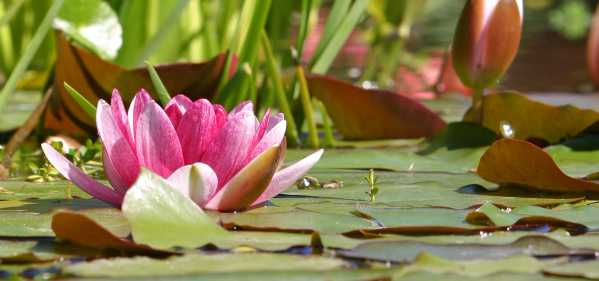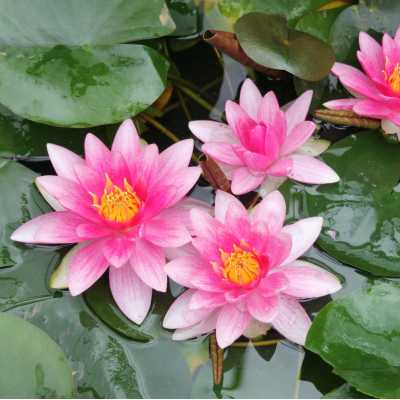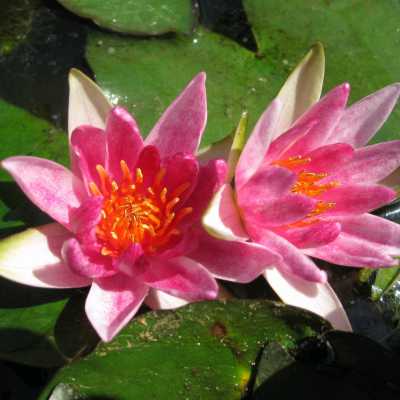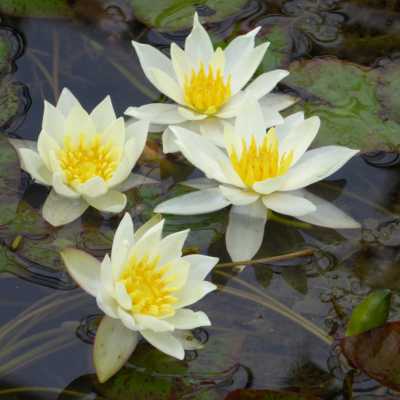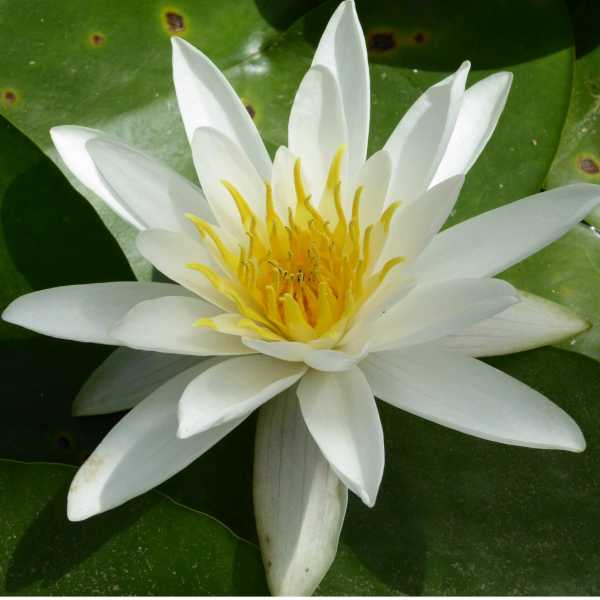Water lilies for small ponds
Mini or small water lilies are known as Pygmaea water lilies. These varieties are ideal for small ponds and water features such as half barrels. The pygmaea water lily has tiny leaves and delicate flowers and are suited to shallower water 30-60cms deep. For a yellow mini lily consider the Pygmaea Helvola is a firm favourite, while for red the Pygmaea Ruba is popular.
Water lilies for average sized ponds
For an average size garden pond we suggest buying a lily for our medium water lily range. They can easily spread 100cms and a planting depth between 30-90 cms depending on variety.
Water lilies for larger ponds
When a large amount of coverage is needed, a Nymphaea Alba or Attraction will offer an economical solution, with one plant throwing a large pad of leaves and plenty of flowers. There is a huge range of lilies to suit all tastes, from the beautiful deep red of James Brydon to the impressive double-flowered pink M. W Gonnere.
Here is a round up of our top 10 best selling water lilies.
- Nymphaea Darwin - Pink Water
- Nymphaea Alba - White Water Lily
- Nymphaea Attraction - Red Water Lily
- Nymphaea Charles de Meurville - Red Water Lily
- Nymphaea Marliacea Albida White Water Lily
- Nymphaea Colorado - Pink Water Lily
- Nymphaea Virginalis - White Water Lily
- Nymphaea Marliacea Chromatella - Yellow Water Lily
- Nymphaea Joey Tomocik - Yellow Water Lily
- Nymphaea Albatross - White Water Lily
Do water lilies come back every year
Yes, if your water lily is healthy and looked after, it will send up new growth in the spring and die back in the autumn.
What conditions do water lilies like
Water lilies prefer warm, sunny conditions. They should be planted in the correct depth for the variety, usually between 45 and 80cms, while avoiding fast-flowing water or splashing from a fountain.
We recommend removing dead foliage or flowers during the summer months. This avoids them breaking down in the water, which can cause increased nutrient levels, causing algae blooms and possible poor water quality impacting the inhabitants of the pond..
Winter care for water lilies
Ensure your water lily is at the correct depth protecting it from the coldest winter conditions. You can trim back dead foliage to just above the lily crown in the autumn. Trimming back pond plants can help reduce toxin build-up caused by rotting vegetation, which may only become apparent in the spring as the water warms up.
Native water lilies
The only true native water lily in the UK is the Nymphaea Alba, a hardy white water lily.
How to plant a water lily
Water lilies need plenty of nutrition to thrive, and it is essential to replant them in a suitably large basket with heavy loom aquatic compost when they are first purchased or replanted. Additionally, you can buy lily fertiliser tablets to slip into the basket to help promote growth and flowering, particularly beneficial in new, nutrient-poor ponds. TIP: Do not use peat-based compost; not only will it float, but it may contain high nutrient levels polluting your pond
- When planting a water lily, the basket should be a good size for the plant, lined with a hessian or foam liner, then partly filled with soil.
- Place the water lily in the basket with the “crown” pointing upwards and fill the rest of the basket with soil, ensuring the “eyes” are showing.
- To finish off you will need to put some gravel on top to hold the soil down and to discourage fish from disturbing the lily.
- Don’t just drop the plant into the depths. You will need to soak the basket first and then very slowly lower it down.
- Smaller and immature lilies may benefit from being positioned in shallower water to start with and gradually moved deeper over a couple of months.
Can water lilies be planted in a fish/koi pond?
If you have Koi in your pond, you will need to put larger stones on the top of the basket and use a hardy variety of lily. If you have an established koi pond, avoid planting a young water lily as the mature fish will probably destroy the plant before it can establish.
How to protect water lilies from pests and diseases
The main disease to look out for in a water lily is crown rot, whilst pests such as beetles and snails can also be an issue but easily resolved. Learn more about common pond plant problems
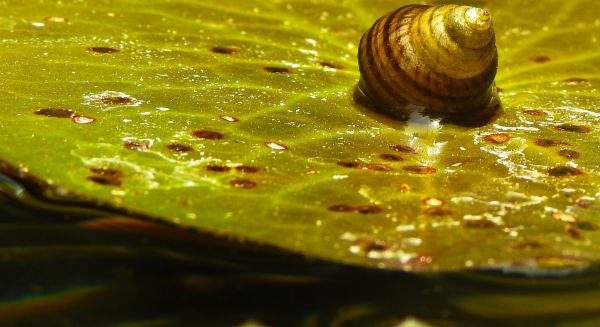
 British Pounds
British Pounds

